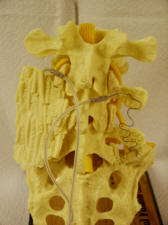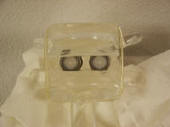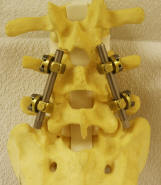fusion : "360"
This type of fusion implies fusion and support for the
anterior and posterior segments of the spinal canal. It has also been
called "belts and suspenders."
Examples would be an
anterior lumbar interbody fusion (ALIF) followed by a posterior fusion
with pedicle screws and rods.
Alternatively, it might consist of a posterior
lumbar interbody fusion PLIF) followed by the placement posteriorly of
pedicle screws and rods.
Another approach is to place a tangential fusion cage (POLAR) posteriorly, and
supplement with pedicle screws. Yet another variant would be an
impacted PLIF (posterior lumbar interbody fusion) in which bone plugs are
placed in the interspace between the vertebral bodies, and pedicle screws
are places to compress the bone grafts in place.

 
Above, on the left, is a model of a posterolateral
fusion with bone graft and a bone growth stimulator. In the middle is
a posterior instrumentation with pedicle screws and rods. On the
right, an anterior lumbar interbody fusion with fusion cages packed with
bone graft is seen. A "360 fusion" may provide additional stability and
support, compared to a posterior fusion or an anterior fusion. The
final verdict on this remains to be determined.
As the number of fusion techniques grows, a growing number of questions is
developing surrounding fusion. What is the best technique? Front
or back? What is the best substance to use for a fusion? Does
the patient's own bone heal during a fusion than bone morphogenic protein?
What are the costs of a fusion, and is the cost of performing one type of
fusion versus another type of fusion justified? These and many other
questions about fusion will be answered over time. |

